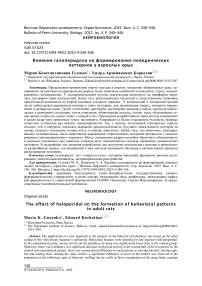The effect of haloperidol on the formation of behavioral patterns in adult rats
Автор: Guzenko Maria K., Korkotian Eduard
Журнал: Вестник Пермского университета. Серия: Биология @vestnik-psu-bio
Рубрика: Экология
Статья в выпуске: 4, 2022 года.
Бесплатный доступ
The application of a new approach to the analysis of the behavior of laboratory rats based on the color coding of the video frame sequence is presented. Behavioral features were identified in rats injected with haloperidol. In the experimental group, motor activity on the periphery of arena was significantly lower than in the control group. Moreover, there was a tendency to a significant decrease in physical activity in the second half of the test period. In the control and experimental groups, there was a pronounced difference in such patterns as moving forward, turning right, left and turning back. Among the static criteria, a significant difference in favor of the control was observed in the proportion of the following types of behavior: sniffing the air, walls or floor, examination of the arena holes, rearings with and without support. The application of the self-developed method, combining three time points in one frame: the present, the nearest and the more distant future, allowed us to establish a number of important rules. Thus, in the group that received haloperidol, the prediction of the future motor pattern based on the current position of the head and/or body of the animal turned out to be much stronger than in the control group. In addition, for animals injected with haloperidol, a pronounced stereotype of motor activity was characteristic. The combined frames were able to provide objectivity and high reliability in the most complex behavioral analysis, the dynamic patterns. In the future, this information will be required to obtain an optimal array and an acceptable variety of data for applying machine learning methods and automating the process of pattern recognition.
Haloperidol, open field test, behavioral patterns, temporal color coding, motor activity, extrapyramidal disorders
Короткий адрес: https://sciup.org/147239684
IDR: 147239684 | DOI: 10.17072/1994-9952-2022-4-340-346
Список литературы The effect of haloperidol on the formation of behavioral patterns in adult rats
- Дроздов А.Л. и др. Влияние психотропных лекарственных средств на спонтанную поведенческую активность белых крыс // Вюник Дшпропетровського ушверситету. Бюлопя. Медицина. 2011. Т. 1, вип. 2. С. 47-53.
- Звездочкина Н.В., Муранова Л.Н., Андрианов В.В. Локомоторные реакции и возбудимость нейронов в условиях блокады дофамина галоперидолом у беспозвоночных и позвоночных животных // Российский физиологический журнал им. И.М. Сеченова. 2004. Т. 90, № 11. С. 1381-1392.
- Сысоев Ю.И. и др. Метод регистрации биоэлектрической активности коры головного мозга у крыс в условиях хронического эксперимента // Российский физиологический журнал им. И.М. Сеченова. 2022. Т. 108, № 2. С. 279-290.
- Amtage J., Schmidt W.J. Context-dependent catalepsy intensification is due to classical conditioning and sensitization // Behavioural pharmacology. 2003. Vol. 14, № 7. Р. 563-567. DOI: 10.1097/00008877200311000-00009.
- Carola V. et al. Evaluation of the elevated plus-maze and open-field tests for the assessment of anxiety-related behaviour in inbred mice // Behavioural brain research. 2002. Vol. 134, № 1-2. Р. 49-57. DOI: 10.1016/s0166-4328(01)00452-1.
- de Souza Caetano K.A., de Oliveira A.R., Brandao M.L. Dopamine D2 receptors modulate the expression of contextual conditioned fear: role of the ventral tegmental area and the basolateral amygdala // Behavioural pharmacology. 2013. Vol. 24, № 4. Р. 264-274. DOI: 10.1097/FBP.0b013e32836356c4.
- Harris L.W. et al. Schizophrenia: metabolic aspects of aetiology, diagnosis and future treatment strategies // Psychoneuroendocrinology. 2013. Vol. 38, № 6. P. 752-766. DOI: 10.1016/j.psyneuen.2012.09.009.
- Irving C.B., Adams C.E., Lawrie S. Haloperidol versus placebo for schizophrenia // Cochrane Database of Systematic Reviews. 2006. № 4. DOI: 10.1002/14651858.CD003082.
- Molodij G. et al. Time-space Fourier кю' filter for motion artifacts compensation during transcranial fluorescence brain imaging // Physics in Medicine & Biology. 2020. Vol. 65, № 7. DOI: 10.1088/1361-6560/ab7631.
- Prut L., Belzung C. The open field as a paradigm to measure the effects of drugs on anxiety-like behaviors: a review // European journal of pharmacology. 2003. Vol. 463, № 1-3. P. 3-33. DOI: 10.1016/S0014-2999(03)01272-X.
- Strange P.G. Antipsychotic drug action: antagonism, inverse agonism or partial agonism // Trends in pharmacological sciences. 2008. Vol. 29, № 6. P. 314-321. DOI: 10.1016/j.tips.2008.03.009.
- Tecott L.H., Nestler E.J. Neurobehavioral assessment in the information age // Nature neuroscience. 2004. Vol. 7, № 5. P. 462-466. DOI: 10.1038/nn1225.
- Wahlsten D. Mouse behavioral testing. How to use mice in behavioral neuroscience. Elsevier: Academic Press, 2011. 304 p.


